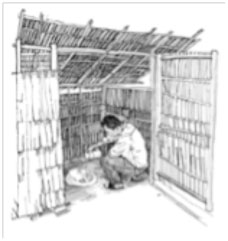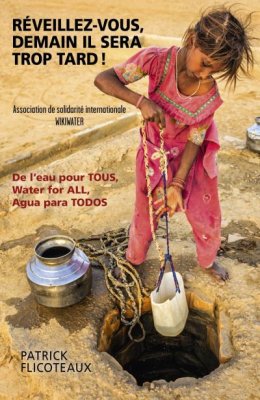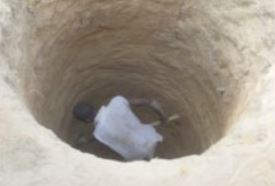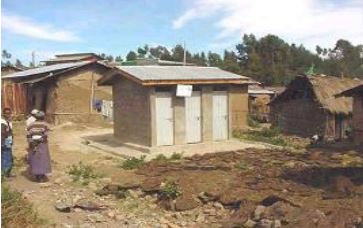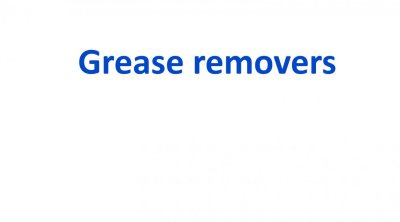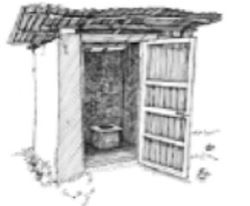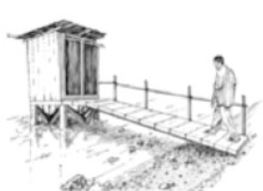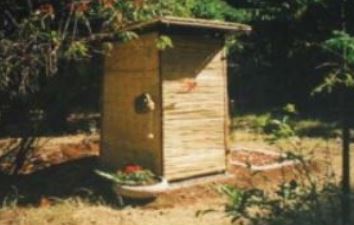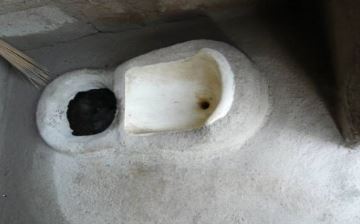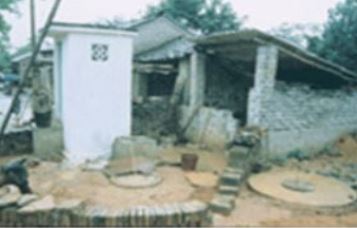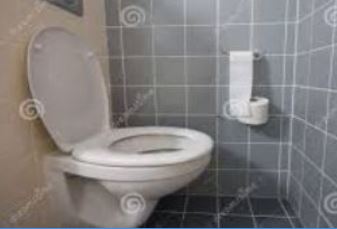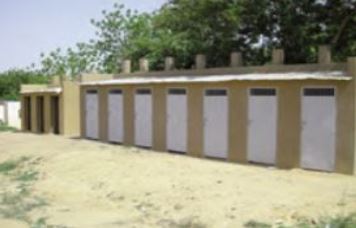1) What is involved ?
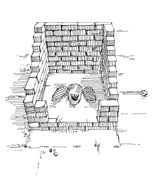
 The simplest, and in many areas, the most widely used, type of toilet, characterised by the collection in a single pit, and with no use of water, of excreta and other human organic materials, requiring no connection to a mains sewer, and already better and less risky than simple holes, leafy areas or slop buckets.
The simplest, and in many areas, the most widely used, type of toilet, characterised by the collection in a single pit, and with no use of water, of excreta and other human organic materials, requiring no connection to a mains sewer, and already better and less risky than simple holes, leafy areas or slop buckets.
( Drawings provided by WEDC, University of Loughborough, UK )
2) Why use this means ?
The discharging, without precautions, of human faeces and urine (excrement) contaminates the soil and water supply sources. These faeces may also form sources of infestation where insects proliferate and spread infection. They therefore at least have to be collected in a pit, which isolates them and prevents direct contact with people or the environment. This is what this means allows, which has also the advantage of being inexpensive
3) Who is primarily concerned ?
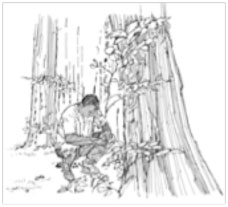 The ease, speed and low cost of installing a single-pit latrine makes this method attractive for people living in rural areas, in places with minimal amount of available space, or in poor, dry or suburban areas and not provided with collective sanitation systems and who hitherto had to relieve themselves in the open air (1.2 billion people in 2008) or in a very rudimentary way (800,000 people).
The ease, speed and low cost of installing a single-pit latrine makes this method attractive for people living in rural areas, in places with minimal amount of available space, or in poor, dry or suburban areas and not provided with collective sanitation systems and who hitherto had to relieve themselves in the open air (1.2 billion people in 2008) or in a very rudimentary way (800,000 people).
There are a few characteristics of this type of latrine (elevated latrine, suspended latrine, twin-pit latrine, etc.) that are better adapted to particular situations such as shallow groundwater areas, wetlands or floodable areas or areas with hard soils.
4) What does this process involve ? How is it used ?
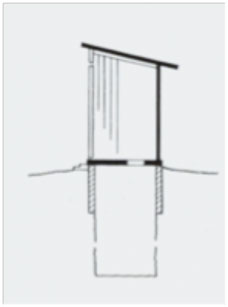
Cross-section of a dry, single-pit latrine
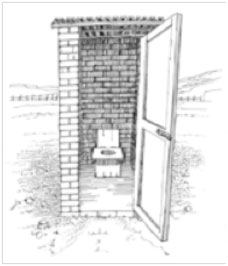 It involves digging a pit, if possible at least 2 metres deep, surmounted by a perforated floor or better still, a slab with a hole in it, and a light superstructure of the shed type.
It involves digging a pit, if possible at least 2 metres deep, surmounted by a perforated floor or better still, a slab with a hole in it, and a light superstructure of the shed type.
Faeces drop directly into the pit, usually through a simple "squat" hole from a crouched position, but also from a more comfortable, albeit rudimentary, pierced seat.
Dry wiping is the best practice in this case (use of leaves, sawdust, grass, thin paper, etc.).
Solid matter piles up in the pit while the liquids (urine and possibly wash water) percolate through the surrounding soil.
The excrement in the pit decomposes due to two types of bacteria (aerobic and anaerobic) that proliferate in the soil. Pathogenic bacteria do not survive more than two years. The final products of this decomposition also contain valuable nutrients to the soil on which trees are sometimes planted when the pit is full.
a) Pit form
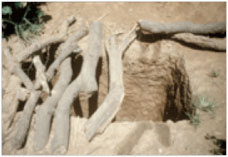
Pit latrines should replace "leafy" areas
Can be circular, square or rectangular. The shallowest pits are usually square or rectangular while pits more than 2 metres deep are usually circular, and have linings that are structurally more stable and able to withstand higher loads (concrete slab, superstructure and user).
The deeper the pit, the higher the pressure exerted on the walls, which may require appropriate protective linings but which allow the percolation of liquids into the surrounding soil.
Their diameter (or width) is usually between 1 m and 1.50 m if only to facilitate terracing work
b) Lining of pit walls
This is not necessary if the ground is stable and there is no risk of groundwater contamination.
However, it is preferable to provide a permeable lining if this risk does not exist but the soil may be unstable.
A waterproof lining should be provided if the soil is permeable (sand, gravel, etc.) and may pollute a water resource within a radius of thirty metres.
c) Pit sizing
Its volume V in m3 can be calculated easily using the following formula : V= Ta x Cu x N x D :1000
where Ta is the accumulation rate, or normal volume, of excrement sludge, which is often, unless more accurate local information is available, between 40 and 50 litres/user/year, where Cu is the use factor for one year and which is generally considered to be equal to 0.4 (e.g. for a school latrine) and 1 (for a latrine in a dwelling), where N is the number of users and D is the latrine’s anticipated service life in years.
It is, however, preferable to add to this calculated volume the volume corresponding to a free space of thirty cm below the slab when the pit is considered full.
d) Slab
Is fairly simple to design, make (concrete, sturdy planks or logs, or if not, other materials such as bamboo covered with gravel, old frames, etc.) and to install.
It is better to install it between 10 and 15 cm above ground level so that surface water does not enter the pit
(if not, dig a ditch to drain off water around the latrine)
Make sure that the edges of the slab overlap the soil surface slightly (for example, by about ten cm for a pit one metre in diameter) to ensure proper support.
e) Superstucture - Stall
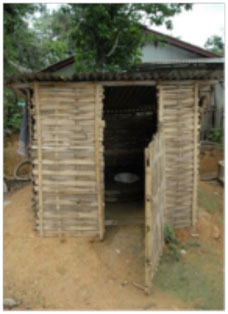
Lao latrine in Xieng Ngeun
This is important as it is what helps to make use of the latrine more discreet, comfortable and pleasant.
The choice and the cost of the model and its materials (bricks, blocks, planks, rods and fabrics, bamboo etc.) depends on the income, wishes and habits of users or their region.
The door can be made of wood, corrugated iron or even strips of bamboo or locally available plants that can be attached to old planks or a wooden frame. When wood or iron plate is too expensive, even simple curtains can be used.
The door must open outwards to provide more room.
The roof must be waterproof. It is often made of fibre cement or iron plate (although often at a high price and with a risk of heat or unpleasant smells inside).
It may also be made of local materials, which often also look better (stubble, leaves, reeds, bamboos, etc.) provided they are covered with a waterproof material or a plastic sheet.
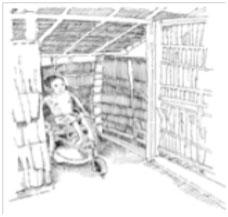
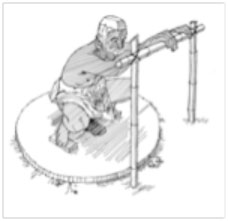 The interior layout can be improved by providing a seat above the hole in the slab, a wooden support bar, or a seat which can be removable for any disabled people, and a small bucket of sawdust, leaves or water for anal cleaning.
The interior layout can be improved by providing a seat above the hole in the slab, a wooden support bar, or a seat which can be removable for any disabled people, and a small bucket of sawdust, leaves or water for anal cleaning.
If the pit is shallow and therefore with a short service life calling for the latrine to be moved when it is full, it is better to build a fairly simple, movable stall.
f) Ventilation
To allow air to enter the latrine and avoid excessive odours, openings should be made in the superstructure, especially above the door and at the bottom of a wall. The air inlet will be more effective if it is facing the prevailing wind. However, the most effective system to prevent odours is the so-called VIP (Ventilated Improved Pit) latrine : See fact sheet A8 "Ventilated improved pit latrines"
g) Service life
Is long and more often than not 15 to 20 years, and sometimes up to 25 to 30 years.
If, given the type of land, the expected life of a latrine is less than 10 years, for example, it is better to consider building a twin-pit latrine with each pit being used alternately for a period of about 2 years.
See fact sheet A7 "Twin-pint latrines".
h) Emptying the pit
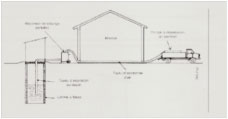
Source RéFEA-WHO 
Emptying can pose significant risks if not done carefully due to the presence of pathogenic micro-organisms in faeces.
In a rural or mountain area, it is often possible and cheaper to close the pit, cover the ground before it is full and not touch it again for one to two years, to allow time for any health issues to be eliminated, and to dig a second pit and then, several years later, a third pit or, especially if the soil is hard, return to the first pit which can then be safely emptied and even used as fertiliser. It is recommended to provide a lightweight, removable latrine superstructure to avoid having to rebuild it.
In a town, where land is scarcer, the pit should be periodically emptied as the faeces in it contain, especially the more recent ones, contain a very large number of pathogens in the sludge deposited in it and the cost of the pit interior lining and its superstructure is generally higher. Manual removal should be avoided. When streets are not too narrow and the cost is affordable, a pit is best emptied with a vacuum tanker truck or if not, connect the tanker truck by a vacuum pipe to a portable tank brought close to the latrine. In many slums, however, the manual means most often used (carts, rickshaws, etc.) are much more basic and are, moreover, sometimes the only means of emptying compatible with both the population’s resources and the narrowness of the streets..
5) Precautions to be taken
Priority should be given to preventing any risk of contamination of water supplies.
1) the surface soil must be dry, firm, well drained and not floodable. If not, a suspended latrine should be provide instead (see below)
2) the bottom of the latrine must not reach the groundwater.
3) the minimum distance between a latrine and a water point or a water source varies according to the land. A few examples are given below
- 100 m if the groundwater is reached (wet pit) and the ground is very permeable (sandy soil)
- 20 m for dry pits in clay soil (if the bottom of the pits is located more than 3 metres above the water table).
- In areas containing fissured rocks or limestone formations, great caution must be used as pollution can flow directly through faults to sources.
4) the location of a latrine must be chosen downstream of a stream or a water point if there are any nearby.
It is also preferable to use dry wiping (thin paper, sawdust, leaves, grass, etc.). It may, however, be used with small quantities of water (washing hands or anal cleansing)
A hand basin should also be provided inside or nearby, especially in the case of a community latrine (usually, however, of an improved type) as it is important to get users used to washing their hands after using the latrine. This hand basin may consist of three items : a small tank, a tap and a base, but may, where appropriate, be limited to a water container and a bowl or a water point, or may be provided using a rudimentary system for recovering rainwater from the latrine roof.
6) Main advantages and drawbacks
a) Advantages
- Easy to build and possibility of using many local materials.
- System easy to understand and maintain.
- Water not needed, or only used in very small quantities.
- Low cost.
b) Drawbacks
- System not sealed which may cause inconvenience, bad smells or diseases because of flies or mosquitoes that may infest the superstructure if each user is not made to close the door properly and above wall effectively place a lid back over the hole in the slab or the seat of the latrine after each use.
7) Cost
Single-pit latrines are the least expensive standalone sanitation systems.
Their price usually varies from €60 to 90 according to the quality of materials used, the pit depth, the superstructure type or interior layout and the region.
8) Places or contexts in which this technique appears to be the best suited
Although single-pit latrines are mostly used in rural or mountainous areas or in areas of low housing density and quantities of available water, they are also sometimes used in suburban areas.
9) Observations, recommendations and suggestions
Give careful thought to the volume of the latrine pit, its location (distance from groundwater and any water points, and distance away from dwellings for bad smells).
Assess pollution risks
Take into account the land type, the resistance of walls to collapsing, the wishes of the family or population, the latrine type most often already built in the area, whether or not by specialized craftspeople.
Find out about inexpensive materials available in the region.
10) Variants used in specific contexts
There are at least 4 variants : twin-pit latrines, elevated pit latrines, borehole latrines and suspended latrines.
Their description and characteristics are given in FACT SHEET A7
11) Where to obtain further information - Bibliography
a) Websites
- OIE (Office international de l’eau) and its access to various websites, such as the Réseau RéFEA (French-speaking telematics centre on water which has several short and accurate fact sheets on various types of sanitation systems including several on single-pit latrines (shown at the top).
http://www.oieau.org/ReFEA/module3b...
- Global Water initiative (West Africa) recently published in French a 25-page very easy to under and use "Practical guide for building a single-pit latrine".
This well illustrated guide is designed to provide step-by-step help for families who have decided to build this type of latrine
http://www.crsprogramquality.org/st...
- WEDC (Water, Engineering Development Centre) website, in English only, made available by Loughborough University which publishes a number of clear, concise Technical Briefs. To obtain the one on single-pit latrines, click the "Latrine slabs and seats, Brief No. 45" line in the contents :
http://www.lboro.ac.uk/well/resourc...
- PSEau (Programme solidarité Eau-32 rue Le Pelletier 75009 Paris)
www.pseau.org  ; Enter single-pit latrines in the "Search" Section
b) Videos
- Short 3’ video entitled Construction of a latrine in the DRC" showing how to build a single-pit latrine and its superstructure with simple local materials.
Downloadable by clicking on : http://www.youtube.com/watch?v=ZneX...
- Other interesting 4’ video without commentary shot in Mozambique : "How do you build a VIP latrine ?" Downloadable by clicking on : http://www.youtube.com/watch?NR=1&a...
c) Bibliography
Action against Hunger : "Water - Sanitation - Hygiene for populations at risk"
Comprehensive book containing 745 pages published by Hermann 6 rue de la Sorbonne 75006 Paris (€50) explaining and illustrating the various techniques used by ACF and pages 435 to 442 of which cover dry latrines.



